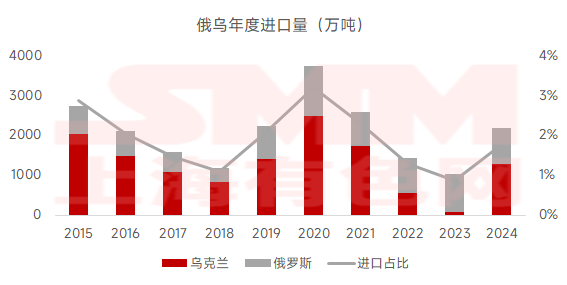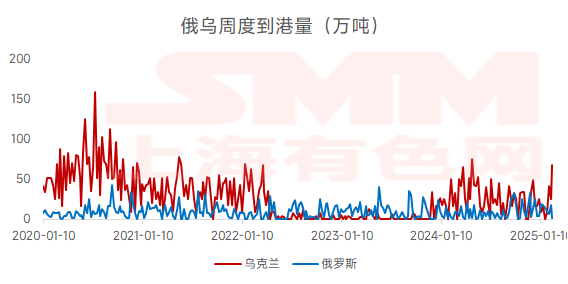On February 21, Trump stated at the White House that he had a very good meeting with Putin and believed there was an opportunity to reach a Russia-Ukraine peace agreement. Meanwhile, the US had proposed a UN draft resolution on the Ukraine issue, titled "Path to Peace." White House Press Secretary Caroline Leavitt stated on February 22 local time that Trump "is confident in reaching an agreement with Russia" to end the Ukraine crisis and mentioned that negotiations could be completed "as early as this week." Previously, Trump had also remarked that Zelensky's attendance at the meeting "was not that important." Could the end of the Russia-Ukraine conflict lead to a significant increase in iron ore supply?
SMM reviewed the iron ore import volume from Russia and Ukraine to China in recent years. Data showed that the iron ore import volume from Russia and Ukraine accounted for only 0.87-3.2% of the total imports. The year 2020 saw the highest import volume from Russia and Ukraine, totaling approximately 37.42 million mt, accounting for 3.2% of China's total iron ore imports, marking a 10-year peak. The Russia-Ukraine conflict significantly impacted Ukraine's iron ore exports, with export volumes plummeting from March 2022 and shipments occurring only sporadically. In 2023, the annual import volume dropped to its lowest point. As the conflict eased, Ukraine's iron ore import volume quickly rebounded. According to customs data, Ukraine's import volume was zero in October 2023 but rebounded to 65,700 mt in November and continued to grow, reaching approximately 1.77 million mt in May 2024, the annual peak. However, this was still below the monthly peak of 3 million mt in 2020. In contrast, Russia's import volume remained relatively stable.

Data source: General Administration of Customs, SMM
According to SMM shipping data, from March 2022 to October 2024, Ukraine's iron ore port departures were nearly zero. Starting in November 2023, shipment volumes gradually recovered, with 170,000 mt shipped in the week of November 3, followed by continuous growth, reaching the annual peak of 710,000 mt in the week of April 12, 2024.
Based on import and shipping data, the iron ore import volume from Russia and Ukraine accounted for a relatively small proportion, with limited impact on iron ore supply. Considering that post-conflict reconstruction in Russia and Ukraine may increase steel demand, domestic demand for iron ore in these countries could rise, potentially reducing exports to China. Therefore, steel mills that have increased the use of Ukrainian concentrate since 2024 may need to adjust their material structure. SMM will continue to monitor changes in iron ore import volumes from Russia and Ukraine. For more information, please log in to the SMM database (https://data-pro.smm.cn/).


Data source: SMM
》Click to view the SMM Metal Industry Chain Database



